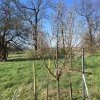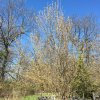I just posted this in the fruit tree section; also posting here to add one caution and leave it where I can easily find it if someone asks me about it in 12-20 months later (I get busy and forget where I posted things!)
Fertilizing is great, fertilizing EARLY is even greater!
I encourage you to try one thing with one tree as a comparison ... even select the worst runt you have, or better yet, try this when you plant your next pear tree.
First, take a 3' or 4' piece of 3-inch pvc pipe and drill 7-10 holes in the pipe in a 2-3 inch wide section on one side of the pipe starting at 4" from the bottom of the pipe and extending to 8" from the bottom of the pipe. This is your water pipe; to be used ANY time you water the tree. When you plant the tree, plant the pipe 12-15 inches away from the tree with the holes in the pipe facing the root zone of the tree. DO NOT drive the pipe in the ground AFTER you plant the tree; it will fill with dirt as you drive it into the soil and defeat the purpose of the pipe. The beauty of a water pipe is the efficiency of watering (and fertilizing) a newly planted tree since all the water goes immediately to the root zone with none on top of the ground to run off. After planting the tree and water pipe, now put a 3X4 or 4X4 piece of landscape fabric under the tree with an inch of pea gravel on top of the fabric. The next step involves the use of straw bales that have been out in the weather for a couple of years; you can slice 2-3 inch "bricks" off of them quite easily. The straw bricks insulate the tree ... preserving moisture during the hottest part of the summer and protecting young roots during the coldest part of the winter. In addition, they extend the growing season by keeping the soil temperature higher during late fall and early winter. Now, place hardware cloth, chicken wire or something around the trunk (I also include black landscape pots with the bottom cut out) and a larger cage around the tree to protect from deer. A mild fertilizer solution (provided early in the spring) and frequent watering (through the pipe) during the first year produce amazing results regarding the growth of a newly planted tree. It's a little more work up front ...... BUT well worth it if you want strong, rapid growth from newly planted trees. Good luck!
P.S. If you use a water pipe make sure you feed a weaker fertilizer solution when you water during the first year; when I first developed the water pipe idea, I scorched a couple of oaks and chestnut trees with too hot a solution going directly to the root zone! You dump 4-5 gallons of H20 on a tree through a water pipe during tthe middle of July (deep saturation) and it should be good to go until mid-september unless you have the hottest, dryest, and most windy August on record!
That is a really great idea! Especially since Phosphate and Potash can't get down to the roots unless liquidized first. At my location I can't water everything so I would imagine it could work against you if you don't have easy enough access to the plantings, or means to water everything through every dry spell if the pipe is permenant. Now you have given air direct access to the roots and drying out below grade when it otherwise would retain moisture longer I would think? Maybe not, just thinking out loud lol


















